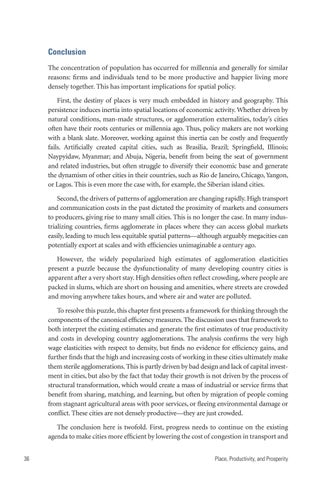Conclusion The concentration of population has occurred for millennia and generally for similar reasons: firms and individuals tend to be more productive and happier living more densely together. This has important implications for spatial policy. First, the destiny of places is very much embedded in history and geography. This persistence induces inertia into spatial locations of economic activity. Whether driven by natural conditions, man-made structures, or agglomeration externalities, today’s cities often have their roots centuries or millennia ago. Thus, policy makers are not working with a blank slate. Moreover, working against this inertia can be costly and frequently fails. Artificially created capital cities, such as Brasilia, Brazil; Springfield, Illinois; Naypyidaw, Myanmar; and Abuja, Nigeria, benefit from being the seat of government and related industries, but often struggle to diversify their economic base and generate the dynamism of other cities in their countries, such as Rio de Janeiro, Chicago, Yangon, or Lagos. This is even more the case with, for example, the Siberian island cities. Second, the drivers of patterns of agglomeration are changing rapidly. High transport and communication costs in the past dictated the proximity of markets and consumers to producers, giving rise to many small cities. This is no longer the case. In many industrializing countries, firms agglomerate in places where they can access global markets easily, leading to much less equitable spatial patterns—although arguably megacities can potentially export at scales and with efficiencies unimaginable a century ago. However, the widely popularized high estimates of agglomeration elasticities present a puzzle because the dysfunctionality of many developing country cities is apparent after a very short stay. High densities often reflect crowding, where people are packed in slums, which are short on housing and amenities, where streets are crowded and moving anywhere takes hours, and where air and water are polluted. To resolve this puzzle, this chapter first presents a framework for thinking through the components of the canonical efficiency measures. The discussion uses that framework to both interpret the existing estimates and generate the first estimates of true productivity and costs in developing country agglomerations. The analysis confirms the very high wage elasticities with respect to density, but finds no evidence for efficiency gains, and further finds that the high and increasing costs of working in these cities ultimately make them sterile agglomerations. This is partly driven by bad design and lack of capital investment in cities, but also by the fact that today their growth is not driven by the process of structural transformation, which would create a mass of industrial or service firms that benefit from sharing, matching, and learning, but often by migration of people coming from stagnant agricultural areas with poor services, or fleeing environmental damage or conflict. These cities are not densely productive—they are just crowded. The conclusion here is twofold. First, progress needs to continue on the existing agenda to make cities more efficient by lowering the cost of congestion in transport and 36
Place, Productivity, and Prosperity

